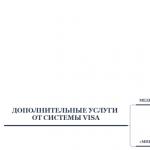Sample calculation of insurance premiums with sick leave. How to reflect compensation from the Social Insurance Fund in the RSV? How to reflect compensation from the Social Insurance Fund in the RSV
Reflection in the lines of Calculation of insurance premiums the amount of benefits for temporary disability with funds paid at the expense of the employer and at the expense of the Social Insurance Fund
Reason: Order of the Federal Tax Service of Russia dated October 10, 2016 N ММВ-7-11/551@ "On approval of the form for calculating insurance premiums, the procedure for filling it out, as well as the format for submitting calculations for insurance premiums in electronic form"
in Letter of the Federal Tax Service dated December 28, 2016 N PA-4-11/25227@ explains:
On line 070 of Appendix No. 2 “Calculation of the amount of insurance contributions for compulsory social insurance in case of temporary disability and in connection with maternity” to section 1 of the calculation, the corresponding columns reflect the amounts of expenses incurred by the payer for the payment of insurance coverage for compulsory social insurance in case of temporary disability and in connection with motherhood.
These lines reflect actual expenses incurred against accrued insurance premiums for the payment of insurance coverage. Amounts paid for the first three days of temporary disability at the expense of the policyholder are not included in these lines, i.e. in Appendix 2 of the calculation of insurance premiums we reflect only benefits at the expense of the Social Insurance Fund; we do not show days at the expense of the employer for the first three days of illness, because these three days do not reduce the amount of contributions due. Also, this amount must be equal to the sum of lines 040 of subsections 1.1, 1.2 of Appendix 1.
Calculation of insurance premiums example for sick leave:
The amounts of benefits both at the expense of the Social Insurance Fund and at the expense of the employer must be reflected in the lines:
030 and 040 Subsection 1.1 and 1.2 Appendix 1 Section 1
020 and 030 Appendix 2 Section 1
210 subsection 3.2.1 Section 3
Appendix 2 Section 1 line 070 - generalized data of Appendix 3 - only at the expense of the Social Insurance Fund

Appendix 3 of Section 1 - Expenses for OSS in case of VNIM - only at the expense of the Social Insurance Fund

The line “Payment attribute” is an innovation in Appendix 2 of the calculation of insurance premiums. Initially, its appearance was associated with the transfer of reporting on insurance premiums to the jurisdiction of the Federal Tax Service. Until now, many company employees responsible for reporting have difficulty deciding which payment attribute to put in the calculation of insurance premiums: 1 or 2. Let’s look at what this parameter means and how to fill out this column.
What is a “Payment Sign”
Before deciding to fill out this line, you need to understand what the “Payment Sign” is: this indicator refers to the system by which payments are made when an employee becomes incapacitated or goes on maternity leave. Today there are 2 main mechanisms.
The first option is the offset type of payments. In this case, the disability benefit is paid in full by the company, and after the payment is made, the Social Insurance Fund compensates the employer for these costs in full.
The second option is direct payment (regions of the FSS pilot project). In this case, the source of finance for payments for temporary disability or maternity is directly the Social Insurance Fund, and the company’s finances are not involved.
Direct payments are available in the following cases:
- payment is based on sick leave (this also includes all cases of disability associated with pregnancy and childbirth);
- payments in connection with the registration of a woman during early pregnancy;
- child care allowance up to 1.5 years;
- payment of 4-day leave to care for a disabled child to either parent.
Thus, in Appendix 2 of the calculation of insurance premiums, the payment attribute is filled in with the number “1” for direct payments and “2” when using the credit system.

Last changes
Traditionally, Russia used an offset system of insurance payments. In this case, the employing organization was responsible to the employee for the fulfillment of social security obligations. All sick leave was paid from the company’s funds, and only then the state, represented by the Social Insurance Fund, compensated for these expenses.
The difficult financial situation often led to the company being unable to fulfill its payment obligations in full. To compensate for these difficulties, a pilot project “Direct Payment” was launched. This happened in 2011.

Since this year, systematically, more and more new regions have been connected to the program through additions to the Decree of the Government of the Russian Federation No. 294 of April 21, 2011.
REFERENCE
Initially, the master plan of the campaign provided for the transfer by 2021 of all regions of the country exclusively to the production of direct payments. However, based on Resolution No. 1514, the expansion of the pilot project for direct payments from the Social Insurance Fund has been suspended.
Today, you can put the code “1” in the “Payment Attribute” column only in the region that participates in the Social Insurance Fund program. A complete list of them participating in the program for 2018 can be found on our website at the link above.
As a result, policyholders can fill out the payment indicator in the calculation of insurance premiums for 2018 with the number “1” in 33 regions.
Appendix 2 is part of the ERSV, filled out for submission to the Federal Tax Service. It is worth emphasizing that an error in filling out the “Payment attribute” field will not cause a fine for the company or employee. However, incorrectly completed items will need to be redone and resubmitted. To avoid this, you need to clarify in advance whether your region is a participant in the Direct Payment project and how to fill out this column.
77 Moscow city
Date of publication: 07/05/2017
Date of letter: 05.07.2017
Number: BS-4-11/12778@
Type of tax (subject): Insurance premiums
Articles of the Tax Code:
Question: On the issue of filling out the calculation for insurance premiums, in particular, reflecting in the calculation the amounts of expenses reimbursed by the territorial bodies of the Social Insurance Fund of the Russian Federation, as well as filling out the calculation by payers registered in the territory of the constituent entity of the Russian Federation, where the pilot project of the Social Insurance Fund of Russia is being implemented, which provides for specific features financial support, assignment and payment of insurance coverage
Answer:
The Federal Tax Service, in connection with incoming requests from territorial tax authorities and payers of insurance premiums regarding the issue of filling out calculations for insurance premiums, reports the following.
1. On the issue of reflecting in the calculation the amounts of expenses reimbursed by the territorial bodies of the Social Insurance Fund of the Russian Federation (hereinafter referred to as the FSS of Russia):
In connection with the adoption of the Federal Law of July 3, 2016 No. 243 - FZ “On amendments to parts one and two of the Tax Code of the Russian Federation in connection with the transfer to tax authorities of powers to administer insurance contributions for compulsory pension, social and medical insurance” (hereinafter - Federal Law No. 243-FZ) powers to administer insurance premiums from 01/01/2017 are assigned to the tax authorities.
Federal Law No. 243-FZ introduced the concept of payment of insurance premiums into Article 80 of Part 1 of the Tax Code of the Russian Federation (hereinafter referred to as the Code), defined as a written statement or application of the payer of insurance premiums, compiled in electronic form and transmitted via telecommunication channels using enhanced a qualified electronic signature or through the taxpayer’s personal account, about the object of taxation of insurance premiums, about the base for calculating insurance premiums, about the calculated amount of insurance premiums and about other data serving as the basis for the calculation and payment of insurance premiums.
In this regard, by order of the Federal Tax Service of Russia dated October 10, 2016 No. ММВ-7-11/551@, the form of calculation for insurance premiums (hereinafter referred to as the calculation) was approved, which came into force on January 1, 2017.
Thus, the calculation includes information that serves as the basis for the calculation and payment of insurance premiums for reporting periods, starting from the 1st quarter of 2017, in particular, information on the amount of expenses of the payer for the payment of insurance coverage for compulsory social insurance in case of temporary disability and in connection with with maternity, reimbursed by the territorial bodies of the Federal Social Insurance Fund of Russia for reporting periods starting from the 1st quarter of 2017.
Amounts of expenses reimbursed by territorial bodies of the Federal Social Insurance Fund of Russia for reporting periods before 2017 are not reflected in the calculation.
In addition, according to clause 11.14. the procedure for filling out the calculation on line 080 of Appendix No. 2 “Calculation of the amounts of insurance contributions for compulsory social insurance in case of temporary disability and in connection with maternity” to section 1 of the calculation, the corresponding columns reflect the amounts of the payer’s expenses reimbursed by the territorial bodies of the Federal Social Insurance Fund of Russia for the payment of insurance coverage for compulsory social insurance in case of temporary disability and in connection with maternity from the beginning of the billing period, for the last three months of the billing (reporting) period, as well as for the first, second and third month of the last three months of the billing (reporting) period, respectively.
In this regard, if reimbursement of the payer’s expenses is carried out in one reporting period for expenses incurred in another reporting period, these amounts must be reflected in the calculation for the reporting period in relation to the month in which the territorial bodies of the Federal Social Insurance Fund of Russia made the specified reimbursement.
2. On the issue of filling out the calculation by payers registered in the territory of the constituent entity of the Russian Federation, where the pilot project of the Federal Social Insurance Fund of Russia is being implemented, which provides for the specifics of financial support, assignment and payment of insurance coverage:
According to clause 2.7. procedure for filling out the calculation of Appendix No. 3 “Expenses for compulsory social insurance in case of temporary disability and in connection with maternity and expenses carried out in accordance with the legislation of the Russian Federation” and No. 4 “Payments made from funds financed from the federal budget” to section 1 calculations are included in the calculation submitted to the tax authorities when payers make expenses for the payment of insurance coverage for compulsory social insurance in case of temporary disability and in connection with maternity.
At the same time, in the constituent entities of the Russian Federation, where, in accordance with Decree of the Government of the Russian Federation dated April 21, 2011 No. 294, a pilot project of the Federal Social Insurance Fund of Russia is being implemented, providing for the specifics of financial support, assignment and payment of insurance coverage (hereinafter referred to as a participant in the pilot project), payment of benefits for mandatory social insurance in case of temporary disability and in connection with maternity is carried out directly by the territorial bodies of the FSS of Russia.
Considering that payers of insurance premiums registered on the territory of a constituent entity of the Russian Federation - a participant in the pilot project, do not pay expenses for the payment of insurance coverage in case of temporary disability and in connection with maternity, respectively, appendices No. 3 and No. 4 to section 1 of the calculation do not are filled out and are not included in the calculation submitted by them to the tax authorities.
An exception is made for payers of insurance premiums who, during the billing (reporting) period, changed their address of location (place of residence) from the territory of a constituent entity of the Russian Federation not participating in the pilot project to the territory of a constituent entity of the Russian Federation - a participant in the pilot project, as well as payers of insurance premiums located on the territory of the constituent entities of the Russian Federation that are entering into the implementation of the above pilot project not from the beginning of the billing period.
In this case, filling out appendices No. 3 and No. 4 of section 1 of the calculation is carried out in accordance with sections XII-XIII of the Procedure.
Bring this letter to the lower tax authorities.
Valid state
Advisor to the Russian Federation 2nd class
S.L. Bondarchuk
The Federal Tax Service draws the attention of users of the reference database to the fact that the information you send about cases of failure by tax authorities to comply with clarifications of the Federal Tax Service of Russia is not:
- an appeal in the sense given to it by the Federal Law of the Russian Federation of May 2, 2006 No. 59-FZ “On the procedure for considering appeals from citizens of the Russian Federation”;
- a complaint against the action (inaction) of tax authorities in accordance with the norms established by Articles 138-141 of the Tax Code of the Russian Federation.
This information will be used by the Federal Tax Service to improve the quality of tax administration and work with taxpayers.
Let's look at the most common inaccuracies. Condition Incorrect position Correct position Determination of the deadline for submitting an updated calculation on the notification of the Federal Tax Service The calculation of the period is made from the date of receipt of the notification The period is calculated not from the date of receipt by the policyholder, but from the date of sending the notification Data on employees who do not receive payments subject to insurance contributions Absence of information in section 3 about employees on parental leave, without pay and others. Section 3 must indicate all insured persons, including recipients of non-taxable contributions. Changes in other taxes when an error is detected and corrected (on profit, unified under the simplified tax system) After making adjustments to the calculation according to contributions do not recalculate other taxes Changing the size of contributions requires a recalculation of the tax base when using contribution amounts to reduce it Question No. 1.
We reflect in the RSV reimbursement of social insurance expenses for the previous year
Order, approved. By Order of the Federal Tax Service dated 10.10.2016 No. ММВ-7-11/, Letter of the Federal Tax Service dated 23.08.2017 No. BS-4-11/): Line 090 = Line 060 – Line 070 + Line 080 In this case, for line 090 the indicator is always reflected in a positive meaning. In the “Sign” field you will need to indicate:
- “1” - “amount of insurance premiums payable to the budget”, if the amount calculated according to the above formula is ≥0;
- “2” - “the amount of excess of expenses incurred by the payer for the payment of insurance coverage over the calculated insurance contributions for compulsory social insurance in case of temporary disability and in connection with maternity”, if the amount is according to the formula<
A sample of filling out the DAM with compensation from the Social Insurance Fund. We provided an example of filling out the DAM in our material. Reimbursement from the Social Insurance Fund for expenses when filling out the DAM will only affect the reflection of information in Appendix No. 2 to Section 1 of the DAM.
Where in RSV for the 1st quarter of 2018? reflect the amount of expenses not accepted for reimbursement by the Social Insurance Fund.
In the column “Total from the beginning of the billing period” of line 090 the calculated value is indicated, and in the column “Characteristic” - 1.
- If the result is negative, then the Fund is in debt. In the column “Total since the beginning of the billing period” the value without the “-” sign is indicated, and in the column “Sign” - 2. Discrepancies As a result, it turns out that line 090 reflects a balance that does not correspond to the accounting data. Because of this, accountants have doubts about whether they filled out the above DAM lines correctly.
In fact, a discrepancy does not mean there is an error at all. It arises due to the specifics of the DAM form - it does not contain cells in which the incoming and outgoing balances should be reflected. Therefore, the amount by which benefits paid in 2017 exceed the amount of contributions is not reflected in the DAM for the 1st quarter of 2018.
How to reflect compensation from the Social Insurance Fund in the RSV?
- Procedure for payment of benefits
- How benefits are reflected in the RSV
- Discrepancies
- How to check
The deadline for submitting the Calculation of Insurance Premiums for the 1st quarter is expiring soon - in 2018, the form must be submitted by May 3 inclusive. In this material we will pay attention to how to reflect last year’s social insurance expenses, which were reimbursed in the 1st quarter of this year. The problem is that, due to the expenses mentioned above, the indicator for line 090 of Appendix 2 to Section 1 does not reflect the actual state of calculations for social insurance contributions.
Let's look at why this happens and what to do. The procedure for paying benefits According to the rules in force today, amounts of sick leave and benefits related to maternity are paid in one of two ways:
- At the expense of the employer with subsequent reimbursement.
How to submit an updated calculation of insurance premiums in 2018
They are reflected in section 1 of the calculation on lines 030 of subsections 1.1 and 1.2 (clauses 7.5, 8.4 of the Procedure) and line 020 of Appendix No. 2 (clause 11.4 of the Procedure);
- payments that are not subject to contribution. They are reflected in section 1 of the calculation on lines 040 of subsections 1.1 and 1.2 (clauses 7.6, 8.5 of the Procedure) and line 030 of Appendix No. 2 (clause 11.5 of the Procedure).
They mean payments that are subject to taxation, but are exempt from taxation by virtue of Art. 422 of the Tax Code of the Russian Federation. Thus, payments that are subject to insurance premiums, but are exempt from their accrual by virtue of Art.
422 of the Tax Code of the Russian Federation, must be reflected in section 1 of the calculation of insurance premiums. Daily allowances within the norms refer to just such payments, since they are not subject to insurance contributions in accordance with paragraphs. 2 clause 1 and clause 2 art. 422 of the Tax Code of the Russian Federation.
Arrears on insurance premiums until 2018 posting
The amounts of employer expenses reimbursed by the territorial bodies of the Social Insurance Fund for the payment of insurance coverage for compulsory social insurance in case of temporary disability and in connection with maternity are indicated in line 080 “Reimbursed by the Social Insurance Fund for expenses for the payment of insurance coverage” of Appendix No. 2 to Section 1 of the RSV (clause 11.14 of the Procedure, approved by Order of the Federal Tax Service of October 10, 2016 No. ММВ-7-11/). The amounts of benefits received from the Social Insurance Fund are shown on line 080 with the following details:
- from the beginning of the calendar year;
- for the last 3 months;
- for the 1st, 2nd and 3rd months of the last three months.
It is important to keep in mind that in the DAM for the current year you must show any reimbursement of benefits from the Social Insurance Fund that was received this year, even if this is reimbursement of expenses from the previous year. Accordingly, the indicator of line 090 of Appendix No. 2 to Section 1 will be determined as follows (clause.
Amount of penalty: Pe = 2,700 x 20 x 1/300 x 8.25% = 14.85 rubles;
- Fine imposed on the enterprise: W = 2,700 x 20% = 540 rubles. The procedure for applying penalties applies to arrears arising after the introduction of new conditions. Penalties for debts of an earlier period are accrued in the previous rate application mode (Read also the article ⇒ Penalties for insurance premiums in 2018: example, postings, calculation). The need to submit an updated calculation when incorrect calculations are identified. The calculation data is checked using control ratios.
The Federal Tax Service Inspectorate’s website contains indicators based on the relationship of which data is verified. Comparison of indicators is carried out based on data from each month.
- accrued insurance premiums;
- benefits paid.
If more contributions are accrued than benefits paid, the difference is transferred to the Social Insurance Fund.
If on the contrary, that is, the difference between contributions and benefits turns out to be a minus sign, then it is counted against future payments or returned from the Fund to the policyholder. Exceptions to this procedure are provided only for benefits for the first 3 days of sick leave.
In July, all employers will submit to the Federal Tax Service a calculation of insurance premiums for the first half of 2017. The new calculation form has been used since the 1st quarter of 2017, and policyholders still have questions about its preparation. We have already written about the procedure for filling out the calculation, and in this article we will look at the nuances of filling out a single calculation for insurance premiums for the 2nd quarter of 2017 using the example of some sections.
An example of filling out the calculation of insurance premiums for the 2nd quarter of 2017 when paying benefits to employees
If the employer paid any benefits to its employees during the reporting period, it is necessary to correctly reflect this in the calculation in order to receive reimbursement of expenses incurred from the Social Insurance Fund. Insurance premiums for compulsory social insurance in the calculation are given in appendices 2, 3 and 4 to section 1.
Example of calculation of insurance premiums with benefits
In the second quarter of 2017, the organization paid sick leave to three employees for 15 days of illness: 5,000 rubles. in April, 6000 rub. in May and 4000 rubles. in June.
These amounts include sick leave paid at the expense of the employer - 3,000 rubles each. in every month. In June, one employee was paid a one-time benefit for the birth of a child - 16,350.33 rubles.
No benefits were paid in the first quarter. Income for the six months paid to employees is 700,000 rubles, including: in April – 120,000 rubles, in May – 119,000 rubles, in June – 115,000 rubles. Number of employees – 5 people. The FSS credit system of payments is used, the tariff is 2.9%.
In Appendix 2 of the calculation, we indicate payment attribute “2” - the employer pays benefits to employees, and then a credit is made against the payment of insurance premiums.
In our example of filling out the calculation of insurance premiums with sick leave, we will distribute the amounts of income (line 020), non-taxable amounts (line 030) and calculate the base for calculating social insurance contributions (line 050). In this case, the amount of all benefits is not subject to contributions, incl. and sick leave at the expense of the employer. On line 060 we calculate contributions for six months and for each month of 2 quarters.
On line 070 we indicate all benefits paid at the expense of the Social Insurance Fund, while we do not reflect the employer’s expenses for the first 3 days of illness (letter of the Federal Tax Service dated December 28, 2016 No. PA-4-11/25227). Personal income tax is not deducted from the benefit amount.
The amount of compensation from the Social Insurance Fund, if there was one in the reporting period, is distributed on line 080.
The calculated amount of contributions on line 060 minus expenses incurred on line 070 is the amount of contributions with the sign “1” payable (line 090). If the amount of expenses is higher than the amount of accrued contributions, line 090 indicates sign “2”. The calculation of insurance premiums for the 2nd quarter, an example of which we give, contains the total amount of expenses exceeding the amount of accruals for contributions; now the organization must reimburse this difference to the Social Insurance Fund.
Expenses for the purposes of compulsory social insurance are also reflected in Appendix 3 to Section 1 of the calculation. These are the following types of benefits paid to employees:
- sick leave,
- women who registered in the early stages of pregnancy,
- at the birth of a child,
- for child care,
- payment for additional days off to care for a disabled child,
- for burial.
Appendix 3, the calculation of insurance premiums for the 2nd quarter of 2017, a sample of which is given, contains our payments. We distribute the benefits paid by type:
- line 010 – sick leave, excluding payments at the expense of the employer,
- line 050 – child birth benefit,
- line 100 – total amount of benefits.
In regions where a pilot project operates and the Social Insurance Fund pays benefits directly to employees, Appendix 3 does not need to be filled out, since the employer in this case only pays for the first 3 days of illness at his own expense, and they are not reflected in Appendix 3.
Appendix 4 is completed only if there are payments made from the federal budget.
Insurance premiums: calculation for the 2nd quarter at a reduced rate
Some insurance premium payers have the right to charge premiums at lower rates than all other insurers. This depends on the presence of certain factors - the use of a special regime, a special location, the performance of a certain type of activity, etc., all of them are listed in Art. 427 Tax Code of the Russian Federation. If usually the general insurance premium rate in 2017 is 30%, then the reduced rate can range from 0% to 20%.
When preparing the calculation, such policyholders fill out one of appendices 5-8 to section 1 to confirm their compliance with the conditions for applying the reduced tariff:
- Appendix 5 is formed by IT organizations (clause 3, clause 1, article 427 of the Tax Code of the Russian Federation),
- Annex 6 – “simplified workers”, whose main activity is indicated in paragraphs. 5 p. 1 art. 427 Tax Code of the Russian Federation,
- Annex 7 – non-profit organizations using simplified language (clause 7, clause 1, article 427 of the Tax Code of the Russian Federation),
- Appendix 8 – IP on a patent (clause 9, clause 1, article 427 of the Tax Code of the Russian Federation).
Example of filling out the calculation of insurance premiums: reduced tariff
An organization on the simplified tax system is engaged in the production of food products, the income from this activity for the first half of 2017 is 8,650,000 rubles. The total amount of income on the “simplified” system is 10,200,000 rubles. According to paragraphs. 5 p. 1 art. 427 of the Tax Code of the Russian Federation, an organization can apply a reduced tariff of 20%, of which “pension” contributions are 20%, and compulsory medical insurance and social insurance contributions are 0%.
In this case, the calculation of insurance premiums additionally contains data - you should fill out Appendix 6 to Section 1:
- on line 060 we will indicate the total amount of income on the simplified tax system for the period from 01/01/2017 to 06/30/2017,
- on line 070 we reflect only income from the main activity - food production for the same period,
- in line 080 we calculate the share of income from preferential activities:
line 070: line 060 x 100%.
If the result obtained is at least 70% of the total income, and the income from the beginning of the year does not exceed 79 million rubles, the right to a reduced tariff, as in our case, is retained.






